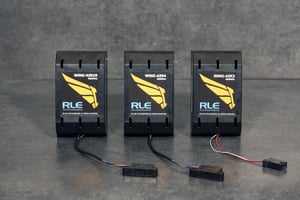It’s been almost a year since RLE Technologies launched their WiNG line of wireless facility monitoring products, and the market acceptance and implementation over the past 12 months has been extraordinary. Featuring a wide variety of sensors, a web interface designed to keep the most relevant information close at hand, and open protocols for unlimited integration, WiNG has been implemented in data centers and critical facilities worldwide. Most notably, customers who have purchased and installed WiNG are coming back to order more systems. Customers love WiNG sensors because they feature:

- A battery life up to 12 years at room temperature
- Up to 600 feet indoor, direct line of sight transmission range
- 98% packet transmission accuracy
- A compact footprint
RLE is excited to launch three new WiNG sensors. With all the features and reliability of the WiNG family of products, these three new sensors are designed to help you fine tune and optimize your data center environment.
WiNG-AIR – Wireless airflow sensors – Poor or obstructed airflow can significantly affect cooling performance and lead to equipment failure. It’s important to detect when your equipment is getting hot, and it’s just as important to know why. Use the wide-range 10m/s WiNG-AIR10, the higher precision 4 m/s WiNG-AIR4, or the more affordable WiNG-AIR3 sensor to keep tabs on air handling equipment and quickly detect stalled fans, leaks, blockages or clogged filters.
WiNG-DAP – Wireless differential pressure sensor - If you’re working to optimize airflow, you need to be aware of differential pressure readings. RLE’s WiNG-DAP sensor allows you to measure the difference in air pressure between one location and another. Use these sensors to measure pressure in your air plenum, in ducts, and across a server racks. Strategically placed WiNG-DAP sensors allow you to gain an understanding of how air flows around your environment and helps you validate the changes you make to baffles, tiles or other air handling equipment is having the desired effect without causing issues in other locations. Wireless sensors are also a great option for differential pressure measurements because they allow you to be agile – measure, identify, and correct air pressure issues in one location, and then quickly relocate the sensor to strategically diagnose air pressure issues in another part of your facility.
WiNG-RTD – Wireless transmitter that accepts one 1K platinum temperature sensor input – If you need to measure temperature in a location that does not allow you to reliably transmit a wireless signal, the WiNG-RTD is your solution. The WiNG-RTD allows you to place a temperature sensor in ductwork, on chilled or hot water lines, or at a CRAC discharge while the transmitter portion of the sensor remains outside that environment, sending the temperature reading back to the WiNG controller.
WiNG sensors are also available in:
WiNG-T – wireless temperature
WiNG-TH – wireless temperature and humidity, with optional calculated dew point
WiNG-DI – wireless transmitter that accepts one wired NO or NC digital input
WiNG-ANLG – wireless transmitter that accepts one wired 4-20mA, 0-5V, or 0-10V analog input
WiNG-LD – wireless leak detection
WiNG-THRM – wireless transmitter that accepts a thermistor input


.png?width=58&height=58&name=X_logo_2023_(white).png)
